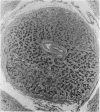Abstract
Two sibships, each with two affected males but no other affected family members, are described. All four patients at birth had small eyes with white masses visible behind clear lenses. Support for a diagnosis of Norrie's disease lies in the probable mental retardation and sudden death of one child and mental retardation in the other in one of the families, and strong support in the sensorineural deafness in one child in the other family. A necropsy was performed on the dead child. Both eyes showed the retinae to be totally non-attached. The optic nerves were thin. If the diagnosis is Norrie's disease (highly probable), the birth of the second affected child in each family supports the postulate of a mutation in the X chromosome of a germ cell of a maternal grandparent or an earlier maternal ancestor, no previous member of the family having been affected. That implies a 50% risk of the disease in future male siblings and a 50% risk of the carrier state in female sibs. When only one child is affected, the explanation could also be a mutation in that individual. Given Norrie's disease, we have calculated a mutation rate of 3.9 per million chromosomes in the Scottish population--remarkably similar to the mutation rates calculated for many dominant diseases. A diagnosis of autosomal recessive non-attachment of retina implies a 25% risk to later siblings.
Full text
PDF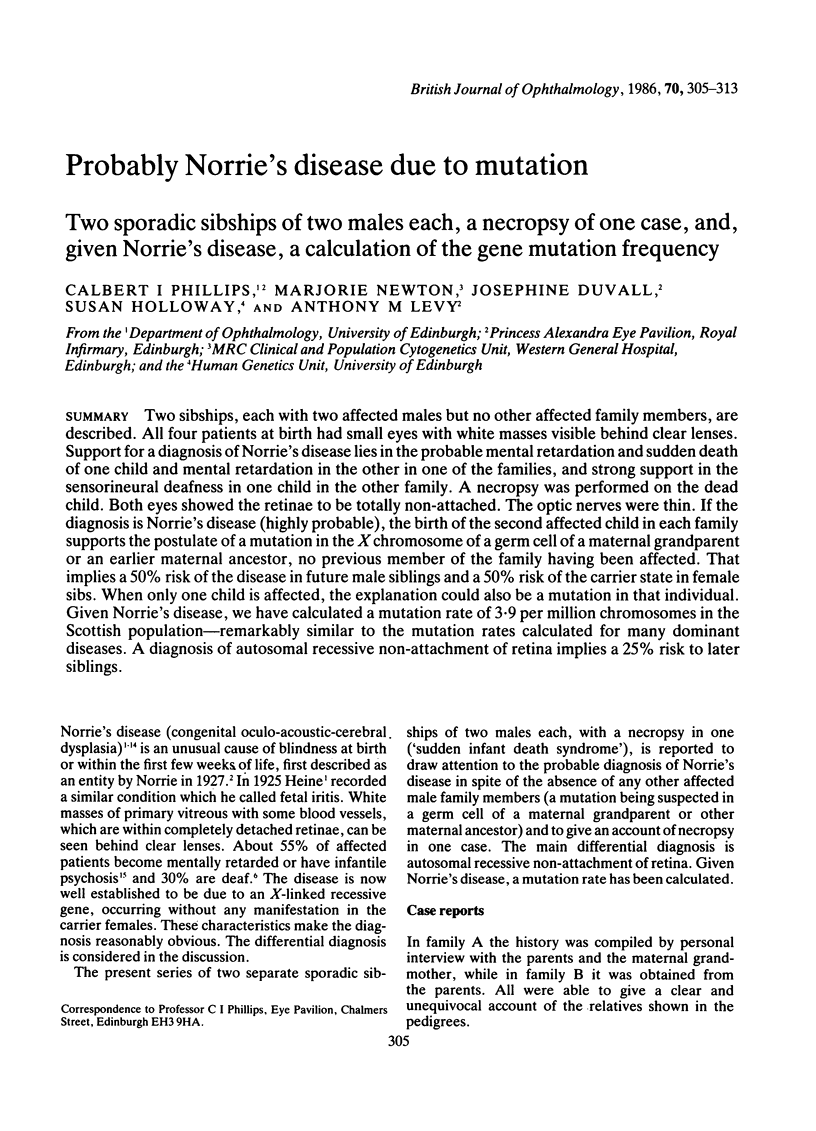
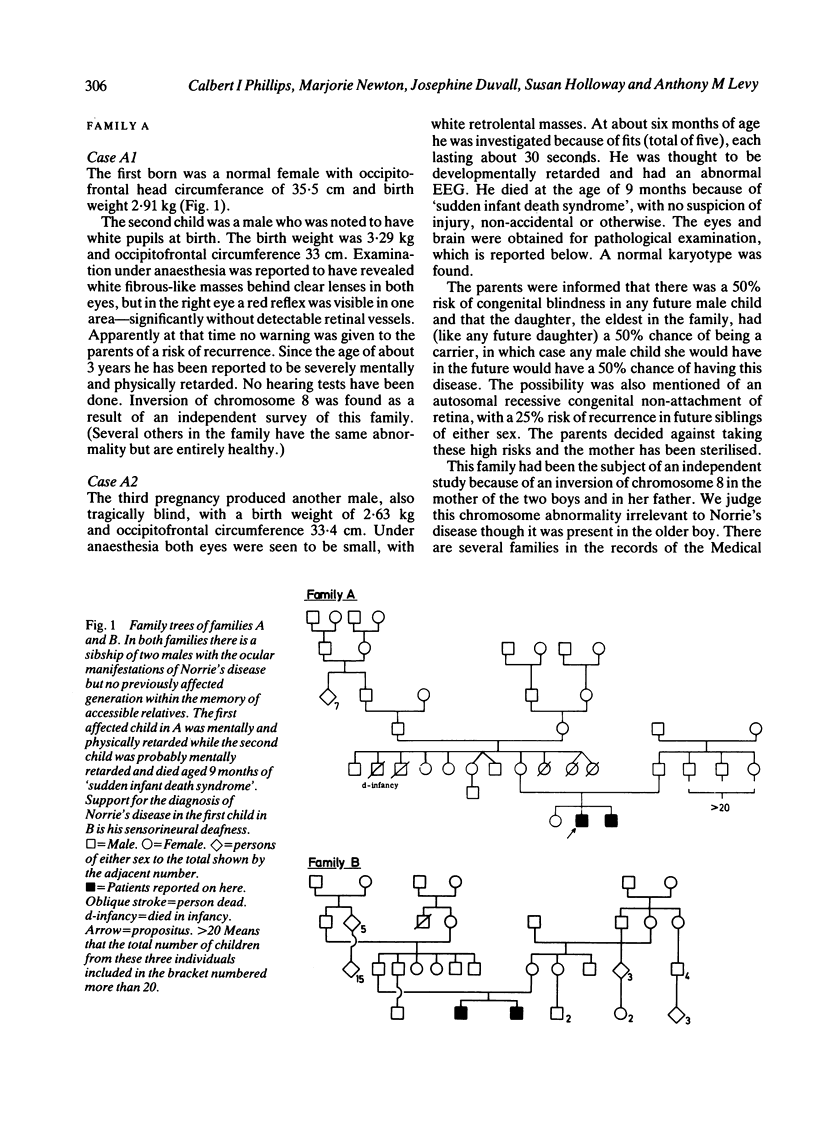
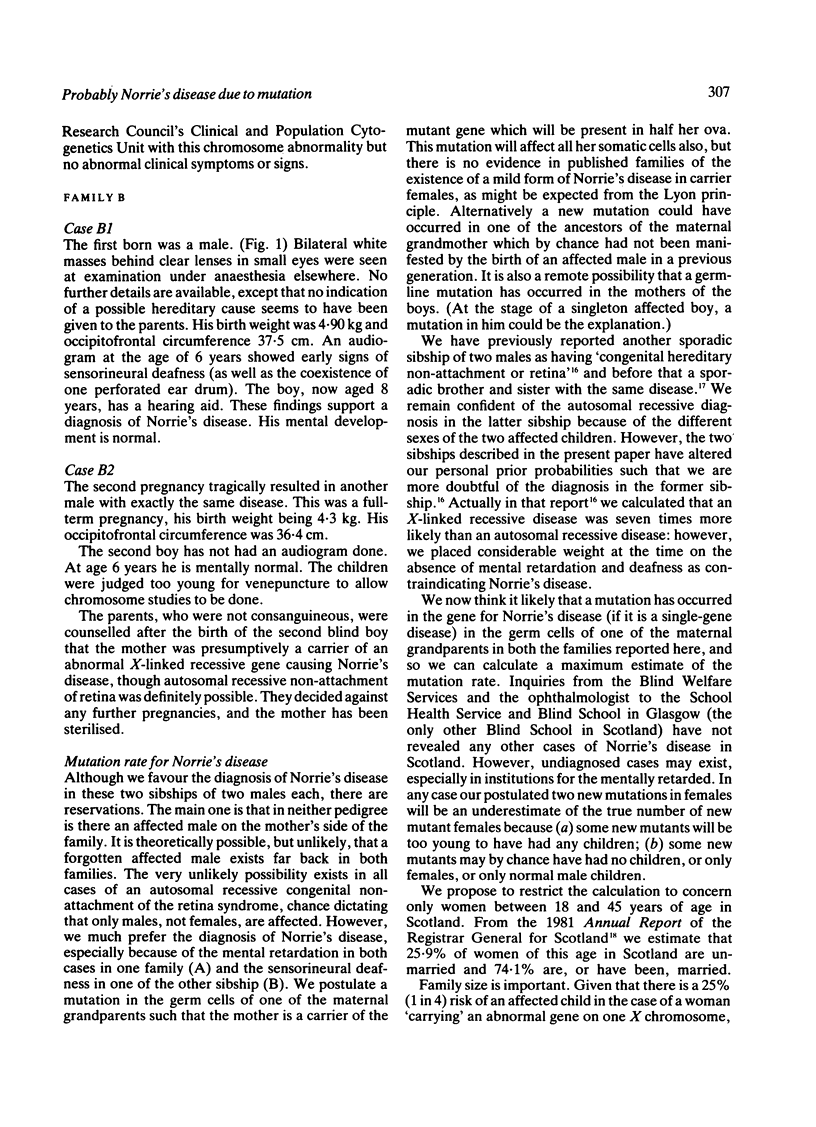
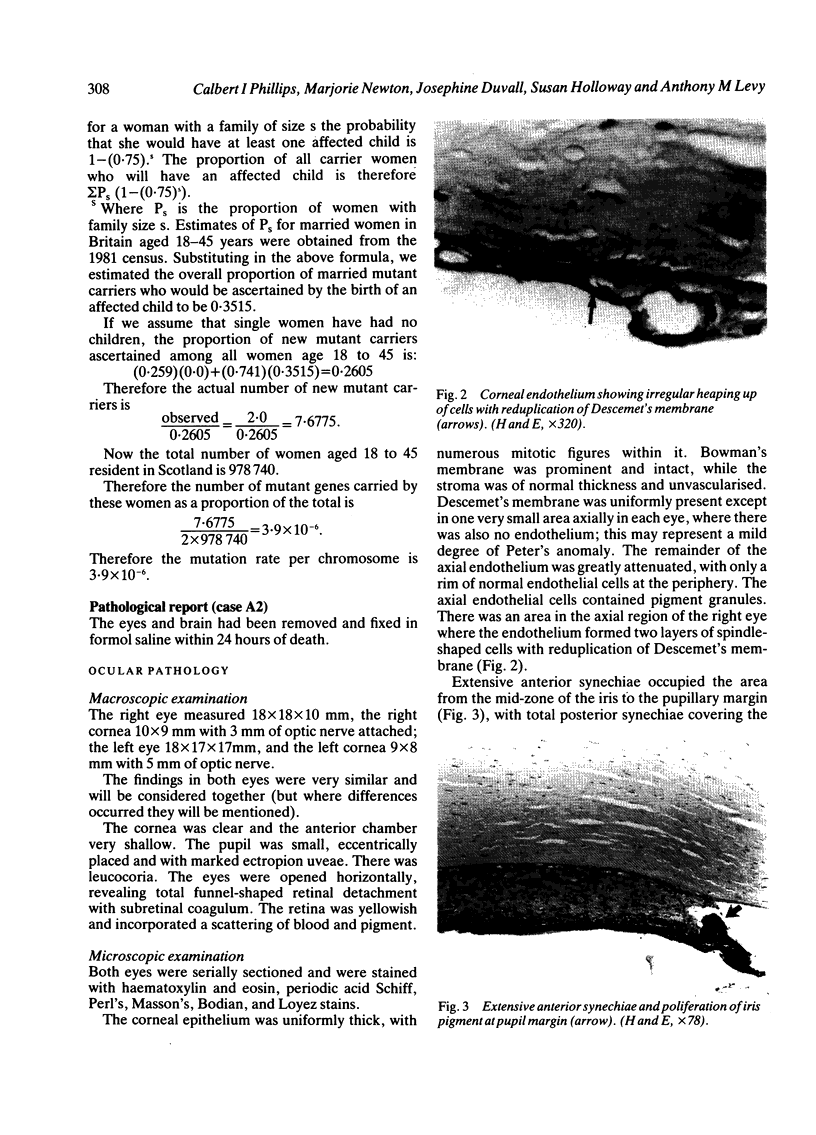
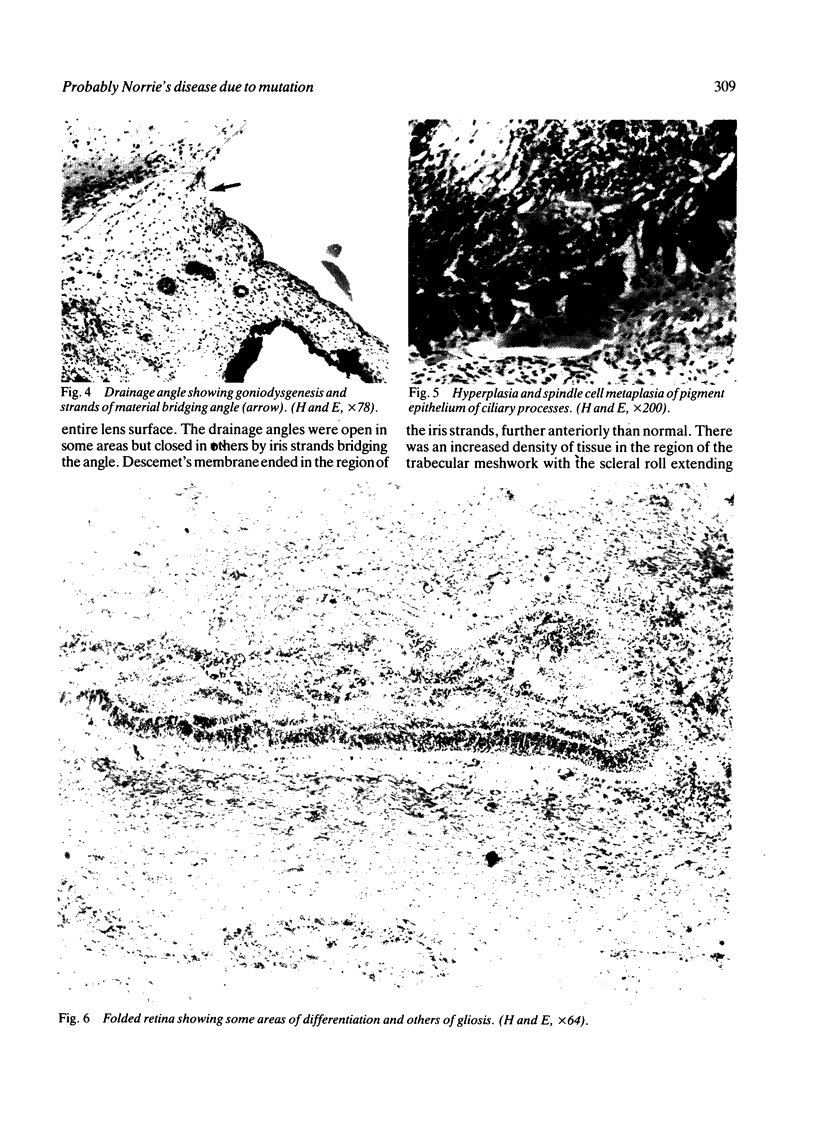
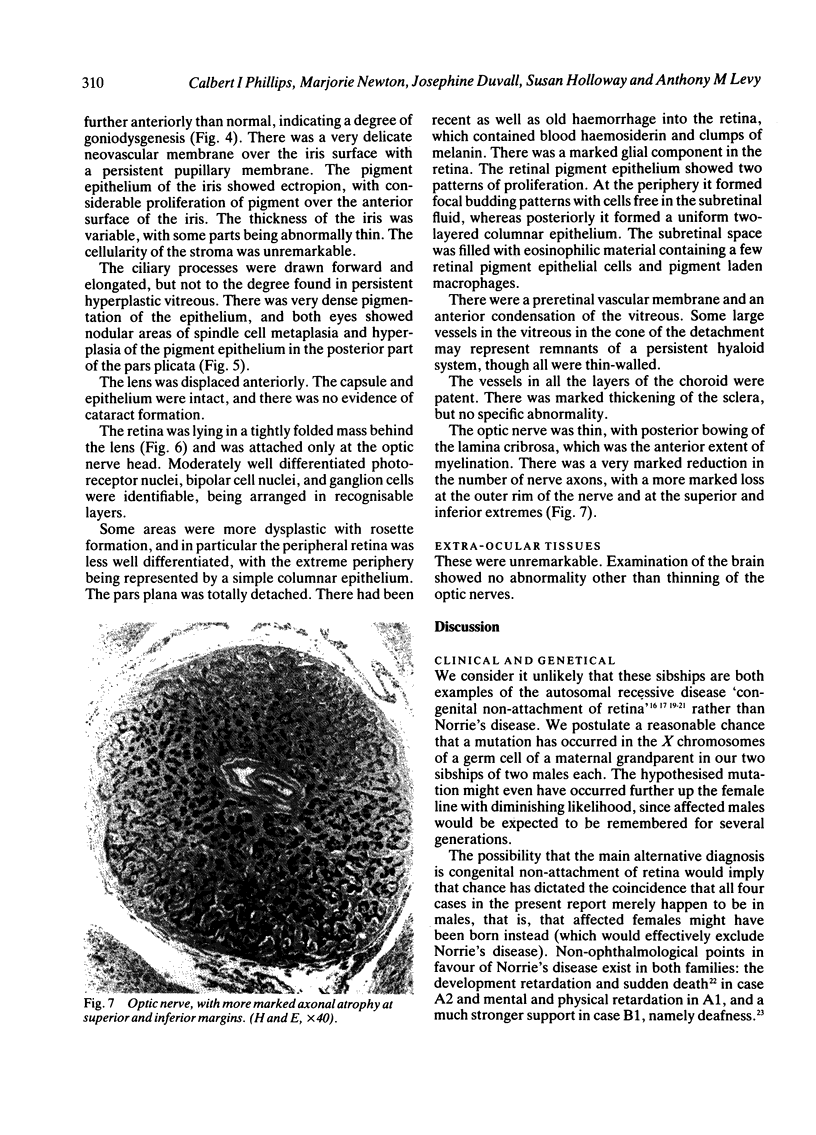
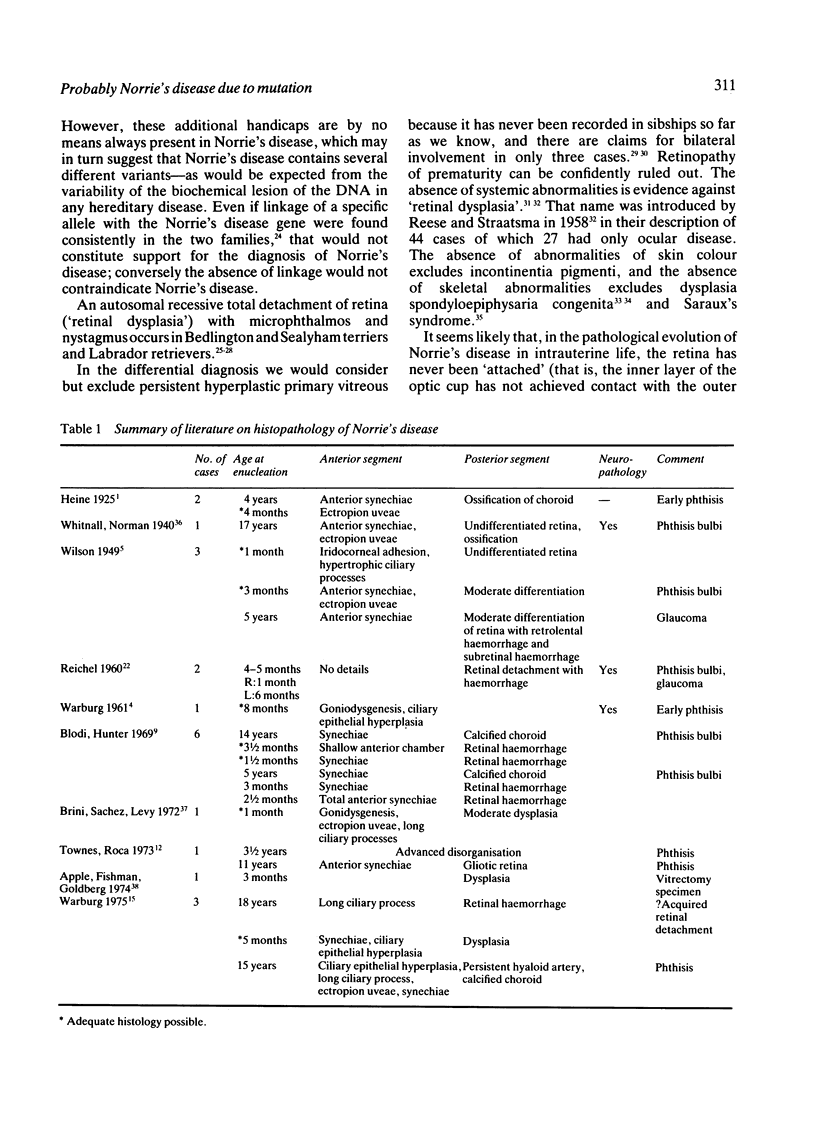
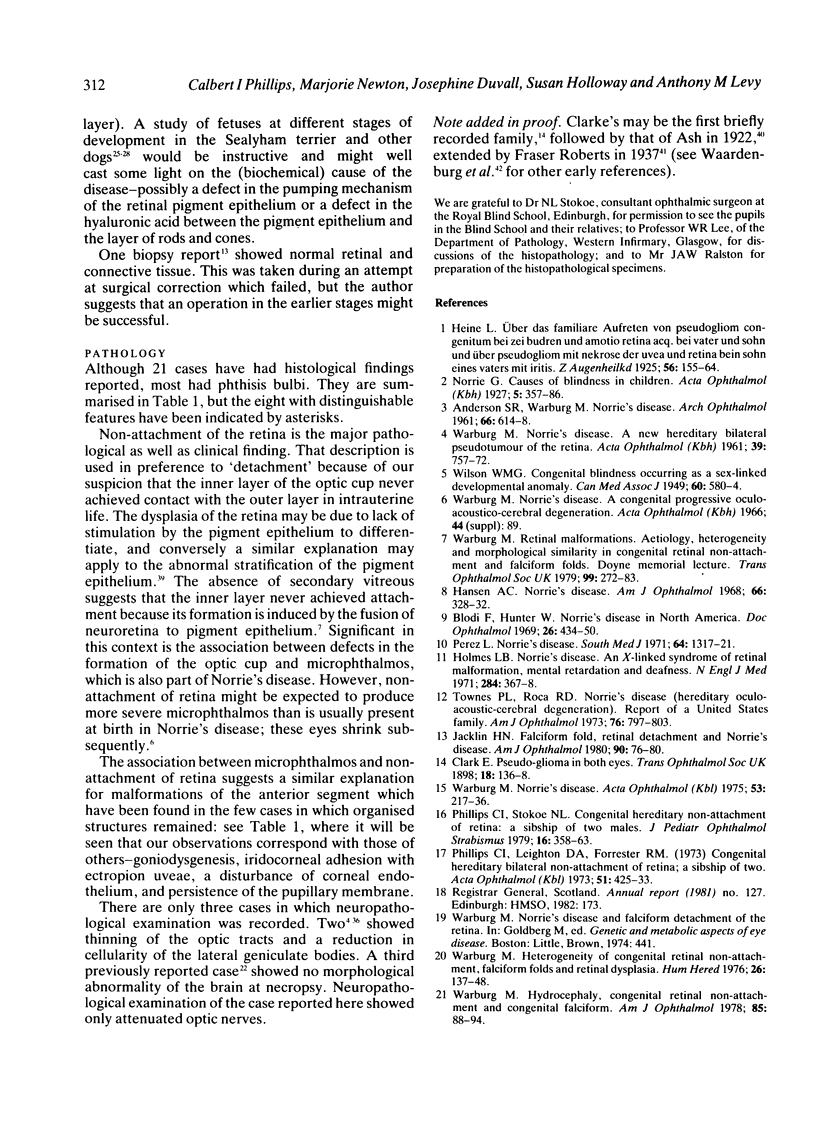

Images in this article
Selected References
These references are in PubMed. This may not be the complete list of references from this article.
- ANDERSEN S. R., WARBURG M. Norrie's disease: congenital bilateral pseudotumor of the retina with recessive X-chromosomal inheritance; preliminary report. Arch Ophthalmol. 1961 Nov;66:614–618. doi: 10.1001/archopht.1961.00960010616003. [DOI] [PubMed] [Google Scholar]
- Apple D. J., Fishman G. A., Goldberg M. F. Ocular histopathology of Norrie's disease. Am J Ophthalmol. 1974 Aug;78(2):196–203. doi: 10.1016/0002-9394(74)90076-2. [DOI] [PubMed] [Google Scholar]
- Ashton N., Barnett K. C., Sachs D. D. Retinal dysplasia in the Sealyham terrier. J Pathol Bacteriol. 1968 Oct;96(2):269–272. doi: 10.1002/path.1700960203. [DOI] [PubMed] [Google Scholar]
- Babel J. Les malformations pseudotumorales du globe oculaire. Ophthalmologica. 1966;151(3):405–426. doi: 10.1159/000304901. [DOI] [PubMed] [Google Scholar]
- Blodi F. C., Hunter W. S. Norrie's disease in North America. Doc Ophthalmol. 1969;26:434–450. doi: 10.1007/BF00944002. [DOI] [PubMed] [Google Scholar]
- Brini A., Sacrez P., Levy J. P. Maladie de Norrie. Ann Ocul (Paris) 1972 Jan;205(1):1–16. [PubMed] [Google Scholar]
- Fraser G. R., Friedmann A. I., Maroteaux P., Glen-Bott A. M., Mittwoch U. Dysplasia spondyloepiphysaria congenita and related generalized skeletal dysplasias among children with severe visual handicaps. Arch Dis Child. 1969 Aug;44(236):490–498. doi: 10.1136/adc.44.236.490. [DOI] [PMC free article] [PubMed] [Google Scholar]
- Gal A., Stolzenberger C., Wienker T., Wieacker P., Ropers H. H., Friedrich U., Bleeker-Wagemakers L., Pearson P., Warburg M. Norrie's disease: close linkage with genetic markers from the proximal short arm of the X chromosome. Clin Genet. 1985 Mar;27(3):282–283. doi: 10.1111/j.1399-0004.1985.tb00221.x. [DOI] [PubMed] [Google Scholar]
- HUNTER W. S., ZIMMERMAN L. E. UNILATERAL RETINAL DYSPLASIA. Arch Ophthalmol. 1965 Jul;74:23–30. doi: 10.1001/archopht.1965.00970040025006. [DOI] [PubMed] [Google Scholar]
- Hansen A. C. Norrie's disease. Am J Ophthalmol. 1968 Aug;66(2):328–332. doi: 10.1016/0002-9394(68)92083-7. [DOI] [PubMed] [Google Scholar]
- Holmes L. B. Norrie's disease--an x-linked syndrome of retinal malformation, mental retardation and deafness. N Engl J Med. 1971 Feb 18;284(7):367–368. doi: 10.1056/NEJM197102182840707. [DOI] [PubMed] [Google Scholar]
- Jacklin H. N. Falciform fold, retinal detachment, and Norrie's disease. Am J Ophthalmol. 1980 Jul;90(1):76–80. doi: 10.1016/s0002-9394(14)75079-2. [DOI] [PubMed] [Google Scholar]
- Parving A., Elberling C., Warburg M. Electrophysiological study of Norrie's disease. An X-linked recessive trait with hearing loss. Audiology. 1978 Jul-Aug;17(4):293–298. doi: 10.3109/00206097809101299. [DOI] [PubMed] [Google Scholar]
- Perez L. F. Norrie's disease. South Med J. 1971 Nov;64(11):1317–1321. doi: 10.1097/00007611-197111000-00003. [DOI] [PubMed] [Google Scholar]
- Phillips C. I., Leighton D. A., Forrester R. M. Congenital hereditary bilateral non-attachment of retina. A sibship of two. Acta Ophthalmol (Copenh) 1973;51(4):425–433. doi: 10.1111/j.1755-3768.1973.tb06021.x. [DOI] [PubMed] [Google Scholar]
- Phillips C. I., Stokoe N. L. Congenital hereditary bilateral nonattachment of retina: a sibship of two males. J Pediatr Ophthalmol Strabismus. 1979 Nov-Dec;16(6):358–363. doi: 10.3928/0191-3913-19791101-06. [DOI] [PubMed] [Google Scholar]
- REESE A. B., STRAATSMA B. R. Retinal dysplasia. Am J Ophthalmol. 1958 Apr;45(4 Pt 2):199–211. doi: 10.1016/0002-9394(58)90244-7. [DOI] [PubMed] [Google Scholar]
- REICHEL G. [On the familial appearance of congenital pseudoglioma]. Arch Kinderheilkd. 1960;162:290–294. [PubMed] [Google Scholar]
- Roaf R., Longmore J. B., Forrester R. M. A childhood syndrome of bone dysplasia, retinal detachment and deafness. Dev Med Child Neurol. 1967 Aug;9(4):464–473. doi: 10.1111/j.1469-8749.1967.tb02300.x. [DOI] [PubMed] [Google Scholar]
- Roberts J. A. Sex-linked Microphthalmia and Mental Deficiency. Br Med J. 1937 Dec 18;2(4015):1213–1216. doi: 10.1136/bmj.2.4015.1213. [DOI] [PMC free article] [PubMed] [Google Scholar]
- Silverstein A. M., Osburn B. I., Prendergast R. A. The pathogenesis of retinal dysplasia. Am J Ophthalmol. 1971 Jul 30;72(1):13–21. doi: 10.1016/0002-9394(71)91586-8. [DOI] [PubMed] [Google Scholar]
- Townes P. L., Roca P. D. Norrie's disease (hereditary oculo-acoustic-cerebral degeneration). Report of a United States family. Am J Ophthalmol. 1973 Nov;76(5):797–803. doi: 10.1016/0002-9394(73)90580-1. [DOI] [PubMed] [Google Scholar]
- WILSON W. M. G. Congenital blindness (pseudoglioma) occurring as a sex-linked developmental anomaly. Can Med Assoc J. 1949 Jun;60(6):580–584. [PMC free article] [PubMed] [Google Scholar]
- Warburg M. Doyne Memorial Lecture, 1979. Retinal malformations: aetiological heterogeneity and morphological similarity in congenital retinal non-attachment and falciform folds. Trans Ophthalmol Soc U K. 1979 Jul;99(2):272–283. [PubMed] [Google Scholar]
- Warburg M. Heterogeneity of congenital retinal non-attachment, falciform folds and retinal dysplasia. A guide to genetic counselling. Hum Hered. 1976;26(2):137–148. doi: 10.1159/000152795. [DOI] [PubMed] [Google Scholar]
- Warburg M. Hydrocephaly, congenital retinal nonattachment, and congenital falciform fold. Am J Ophthalmol. 1978 Jan;85(1):88–94. doi: 10.1016/s0002-9394(14)76671-1. [DOI] [PubMed] [Google Scholar]
- Warburg M. Norrie's disease--differential diagnosis and treatment. Acta Ophthalmol (Copenh) 1975 Mar;53(2):217–236. doi: 10.1111/j.1755-3768.1975.tb01156.x. [DOI] [PubMed] [Google Scholar]
- Whitnall S. E., Norman R. M. MICROPHTHALMIA AND THE VISUAL PATHWAYS: A Case Associated with Blindness and Imbecility, and Sex-linked. Br J Ophthalmol. 1940 May;24(5):229–244. doi: 10.1136/bjo.24.5.229. [DOI] [PMC free article] [PubMed] [Google Scholar]








